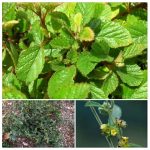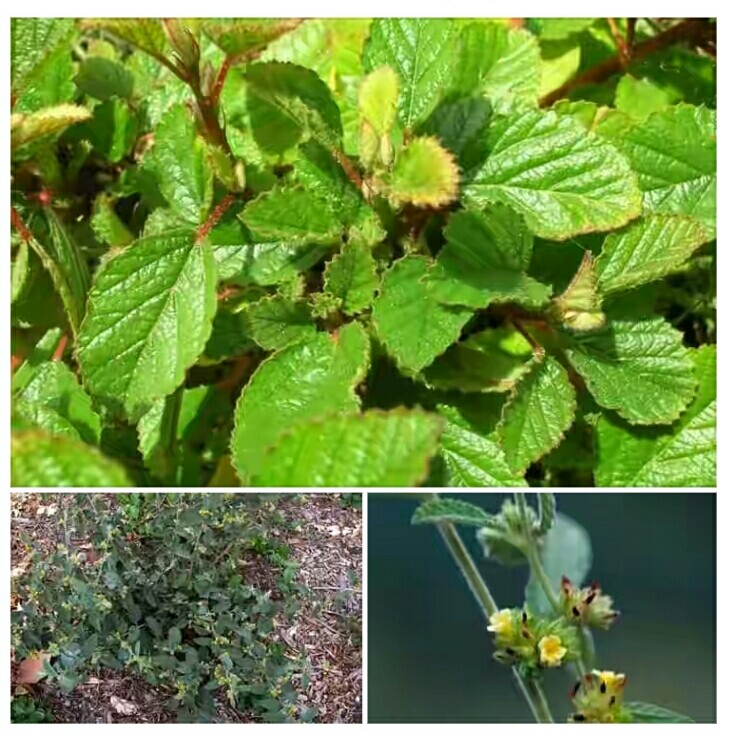Waltheria indica L. (synonyms: Waltheria americana L., Waltheria guineensis Schum. et Thonn., Waltheria africana Schum. et Thonn.) (Botanical name) or Basora-Prieta, Boater bush, Buff coat, Leather coat, Monkey-bush, Sleepy Morning, Uhaloa, Velvet-leaf (English) or Capappi, Kafaffi, Kapappi (Fula-Fulfulde) or Hankufa, Farar hankufa, yankufa (Hausa) or Apiko, Okoro oman (Yoruba): A plant that awaits its full scientific elucidation as a medicinal plant
DESCRIPTION AND OCCURRENCE: Waltheria indica is an erect to spreading shrublet, which is usually 300 mm to 1 m tall. The thin stems, as well as the rest of the plant, are covered with star-shaped and simple hairs. The egg-shaped leaves are greyish green and have a soft zig-zag edge, with a pointed to round tip. The flowers appear throughout the year and are clustered together between the leaves and stems. The flowers have 3 bracts and a cup-like, green (becoming brown with age) calyx with 5 yellow petals, which are fused together at their base and turn reddish brown at maturity. The tiny yellow flowers seem to attract different flying insects, such as bees. The 1-seeded capsules dry out and become brown, and will germinate in suitable moist soil, once they have fallen. The fruits are small, 1-seeded capsules and sit in the calyx cup until becoming brown and dry.
These perennial plants are quite hardy and spread easily. Waltheria indica is found mostly in the northern part of South Africa, extending into Namibia and Botswana and tropical Africa. It is also found in the tropics and subtropics of the old and new worlds. It grows in most habitats, including open grasslands or woodlands, rocky slopes and along rivers, and can be found in human-disturbed areas in sandy soils.
USES OR BENEFITS
The leaves of Waltheria indica are used as a leafy vegetable by the Vavhenda people of South Africa and the plant is used for barrenness by Shangaan woman. The roots, leaves and whole plant have been used to combat sexually transmitted infections, urinary tract infections, and a variety of infant illnesses in Limpopo.
Because of its spreading nature, Waltheria indica makes an ideal pot plant. In West Africa, the plant is used to increase the resistance of an infant and children to fevers. The plant has been used as a febrifuge in many countries of Africa.
The powdered plant is used in the Philippines and elsewhere as an antisyphilitic. The Heikum Bushmen of Namibia chew the roots for their sap when suffering from colds and influenza.
The root is chewed in Tanzania for the treatment of gonorrhoea. In Tanzania, cold water in which the root has been pounded is used as a wash thrice daily for leprosy and should leprosy appear in the throat the root-powder is smoked in a pipe or rolled in a cigarette.
It is an ingredient of the Yoruba “Agbo” infusion given as a drink or in baths for a few weeks after birth to strengthen resistance against fevers. In Senegal, a root decoction with or without twig-bark is drunk for leprosy.
The Hausa people and some Senegalese consider a decoction to be a preventive of syphilis. The Hausa people regard the root as purgative and as restorative during the labours of harvesting.
The Ju, ‘hoansi of Namibia heat the roots in water and drink the infusion before it boils for stomach ailments.
In Panama, it is considered a remedy for haemoptysis (coughing of blood originating from the respiratory tract below the level of the larynx). In northern Nigeria and Togo, a decoction of the root is given as a general tonic to children.
In Burkina Faso, it is given as an anti-diarrhoeal to children. The root is also used as a cough medicine in Togo and in Senegal for healing wounds. The leaves and flowers are said to be mucilaginous and are used in Gambia as an application to sores. In Uganda the plant is named Egweret by the Teso.

A small amount of leaves, because of their mucilaginous nature, are added to those of cowpeas and cooked as a vegetable. Various parts are also employed in veterinary medicine in North and West Africa. The bark yields a fibre similar to jute, but is of no commercial interest.
PROSPECTS: Unfortunately, limited information is available on the phytochemistry and phytopharmacology of Waltheria indica. More research is needed to fully evaluate its future potential.
FOR FURTHER READING SEE:
1. Adam, J.G., Echard, N. & Lescot, M., 1972. Plantes médicinales Hausa de l’Ader. Journal d’Agriculture Tropicale et de Botanique Appliquée 19(8–9): 259–399.
2. Inngjerdongen, K., Nergård, C.S., Diallo, D., Mounkoro, P.P. & Paulsen, B.S., 2004. An ethnopharmacological survey of plants used for wound healing in Dogonland, Mali, West Africa. Journal of Ethnopharmacology 92: 233–244.
3. Kokwaro, J.O., 1993. Medicinal plants of East Africa. 2nd Edition. Kenya Literature Bureau, Nairobi, Kenya. 401 pp.
4. Mongalo N.I., Opoku A.R. & Zobolo A.M. 2012. Antibacterial and antioxidant activity of the extracts of Waltheria indica Linn. collected from Capricorn District, Limpopo Province, South Africa. Journal of Medicinal Plants Research 6(43): 5593-5598.
These are the thoughts and intellectual property of:
Sa’eed Halilu Bawa
Senior Lecturer (Associate Professor) at University of the West Indies, St. Augustine Campus, Trinidad.
Studied Food and Nutrition Sciences, Dietetics at Kaduna Polytechnic, Nigeria; Warsaw University of Life Sciences, Poland.
























